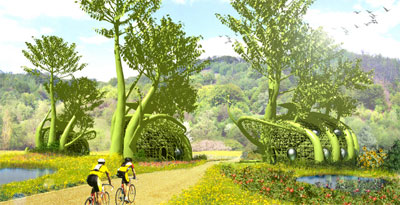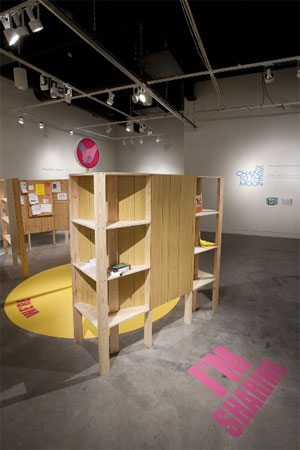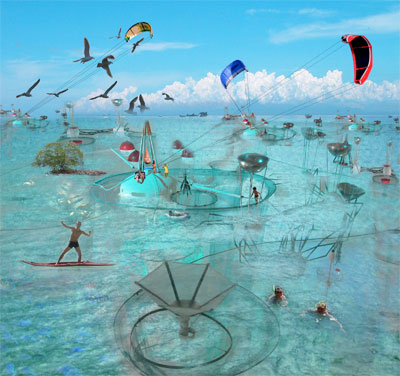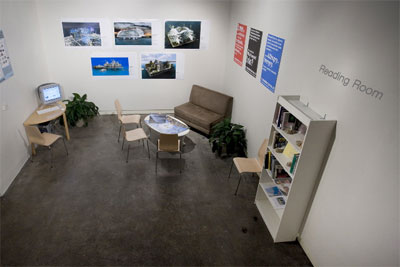


| Utopia Redux: 29 Chains to the Moon |  |
 |
 |
| by Mary Tremonte | |||
| November 2009 | |||
http://glasstire.com/index.php?option=com_content&task=view&id=3772
In what ways are artists, scientists, designers and dreamers problem-solving and envisioning new possibilities for our present and future world? Independent curator Andrea Grover has gathered some compelling possibilities into a new exhibition for the Miller Gallery at Carnegie Mellon University, 29 Chains to the Moon: Artists Schemes for a Fantastic Future. The name of the show is an updated take on the title of Buckminster Fuller's 1938 book “Nine Chains to the Moon,” which references cooperation: if all the human beings alive on Earth stood on each others shoulders, we would form nine chains to the moon. In 2009, that number has grown to 29. Fuller had an optimistic belief that humanity's inherent goodwill and ingenuity could help find solutions to global problems such as shelter, nutrition, environmental pollution and overpopulation.

29 Chains features three artists/collectives: Open_Sailing, Stephanie Smith and Mitchell Joaquim/Terreform ONE, as well as a reading room with information and designs from the Buckminster Fuller Institute, Lowry Burgess, International Space University and the Seasteading Institute. Grover has previously explored "crowdsourcing"—collective problem-solving, bringing together many minds and skills to find solutions—and the projects in this show reflect that mentality. On entering the space, my attention was immediately attracted by Commons(Commune), the plywood kiosk configuration designed by Stephanie Smith as a manifestation of her WeCommune project. An initiative that aims to take some of the best ideas of communes, such as gift economies, bartering and trading, into contemporary urban and suburban situations, WeCommune is an online community-building project based on sharing resources. In the gallery, visitors to Commons(Commune) can gather within its plywood walls, take or leave objects from its shelves or post messages on community bulletin board asking for or offering to share goods and services.

The arrangement recalls a corner store that is slowly going out of business but doggedly hanging on, random dusty wares still clinging to the shelves. What if Smith had filled the shelves prior to the exhibition's opening, or everyone who visited the show was actively invited/compelled to give or take an item? I learned that an original intention was to place the kiosk at different points throughout Carnegie Mellon's campus, but the Miller was limited by university red tape. The potential for sharing, a hopefulness and trust inherent in this display, may have been better realized if it were allowed a more public context. Inside the gallery, the nearly empty shelves give the impression of an invitation to share declined. One is left to wonder: does WeCommune’s translation of small, grassroots efforts at cooperation into a gallery setting and into online networks amplify their appeal after all?

Employing entirely different aesthetics, Terreform ONE fills large swatches of wall space with digitally-rendered futuristic designs for urban transportation and living situations. While computer-generated imagery doesn't appeal to everyone's taste, the mix of organic and geometric forms is alluring. But how feasible is it to translate these fantastic designs into reality? In the podcast, Grover explains: Fab Tree Hab, a housing design of living trees grafted to grow into dwelling shapes, could be farmed, and used as a new prefab design for Habitat for Humanity. Further research online revealed these projects to be more plausible than they appear from the display in the gallery. The science fiction vibe of these designs is an intentional inclusion on Grover's part; she cites numerous instances in which ideas of science fiction writers have become a reality, from Issac Asimov's robotics to Adulus Huxley's cloning. Science fiction can expand our minds to realizable new possibilities.
Likewise, the reading area includes several science fiction texts that speak to this expanded sense of potential. The nook is adorned with posters from the Buckminster Fuller Institute that share inspiring quotes from Bucky, my favorite being: “Love is omni-inclusive, progressively exquisite, understanding and tender and compassionately attuned to other than self.” There are also winning designs from the Buckminster Fuller Challenge Idea Index. Between these printed materials and again, some later investigation on the Internet, one gains a much deeper understanding of the visual proposals presented in this gallery setting.

This is an exhibition of ideas rather than objects. I value visionary interdisciplinary thinking, but as an experience it left me craving more interaction and more information about the designs I was seeing. As part of the exhibition, the Miller hosted a series of events that activated the space, allowing participants to interact more deeply with the projects. Open_Sailing, whose project in the show is a design for a seastead, hosted a workshop that utilized collaborative construction and group dynamics. Among other activities, participants linked themselves together with string, adding and jettisoning threads to create a physical model of how social networks operate. (On an interesting side note, Open_Sailing’s seasted project was visited by a major military think tank.) 29 Chains did lead me to deeper investigation of the ideas introduced here, and maybe that is the greater point with an exhibition of this sort. Perhaps some of these now fantastic-looking visions will push the idea of what is possible into a future where they appear commonplace. In Grover's words: “I truly believe, like Fuller, that the first step to progress is letting go of assumptions and preconceptions about the world, and becoming open to discovery, in the same manner that a child might investigate something it encounters for the first time.”
29 Chains to the Moon: Artists' Schemes for a Fantastic Future runs through December 6th at the Miller Gallery at Carnegie Mellon University, Pittsburgh, Pennsylvania.
![]()
Mary
Tremonte is an artist and writer living in Pittsburgh, PA.